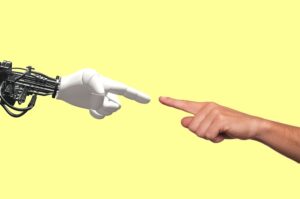
Artificial Intelligence
Something so complicated is also an academic field of study—one that didn’t start yesterday. For some decades now, what has been called “intelligent agents” have been studied, who perceive their environment, understand how they can operate and how best.
What do you mean, intelligent machines?
Artificial Intelligence, in its essence, allows systems to make decisions independently, accurately, and supported by digital data. Which, in an optimistic view, multiplies the rational capacity of human beings to solve practical problems, simulate situations, think of answers, or, more broadly, enhances the capacity to be intelligent.
A new wave of innovation
Economists call this the fourth industrial revolution, marked by the convergence of digital, physical, and biological technologies — blurring the boundaries of the three areas. And AI is part of this next wave of innovation, bringing major changes to the way people and businesses relate to technology, share data and make decisions.
What is artificial intelligence?
We can define artificial intelligence, broadly speaking, as the ability of machines to think like human beings: to learn, perceive and decide which paths to follow, in a rational way, in certain situations. Until then, computers needed three main pillars to evolve from simple computing to today’s artificial intelligence:
Access to large amounts of raw data;
Powerful, affordable computing for fast, efficient processing.
Big Data / Franki Chamaki / Unsplash
With the evolution of these three segments, artificial intelligence finally became possible with the formula: big data + cloud computing + good data models.
We can say that AI learns like a child. Teaching computers to think, however, is not that simple. Salesforce details that the issue involves several areas of computer science as Machine Learning, Deep Learning, and Natural Language Processing. “All these terms together make up all that artificial intelligence is and point to a future in which our platforms and systems will have enough intelligence to learn,” he explains.
So let’s go to the definitions:
Machine Learning:
Instead of programming rules for a machine and waiting for the result, we were able to let the machine learn these rules on its own from the data, arriving at the result autonomously. Personalized recommendations on Netflix and Amazon, for example, indicate titles according to what the user watches. As you enter data (watch) the system learns what you like.
Deep Learning:
When we talk about deep learning, it means an area of knowledge with little or no supervision. The system can learn how to defend itself from attacks on its own.
Natural Language Processing:
This processing uses machine learning techniques to find patterns in large, pure data sets and recognize the natural language. Thus, one of the PLN application examples is sentiment analysis, where algorithms can look for patterns in social media posts to understand how customers feel about specific brands and products.
Where can we find artificial intelligence?
AI is everywhere, in the autonomous car, on the factory floor, and in the care system of hospitals. But it’s also on the social network, on your cell phone, on the antivirus, on the internet search engine. Google, for example, is an example of an AI-first company. In other words, all of its products have machine learning processes.
On Google Photos, you can search for specific objects and situations, from “hugs” to “dogs” and “colors”. Also, the Wizard is always suggesting to create a GIF, montage, or effect.
In Gmail, the search giant’s email, machine learning helped improve the spam filter and, in Google Translator, the move to the translation system with neural machines significantly improved the quality of what was translated. In search, there is RankBrain, an algorithm that uses deep learning to improve the ranking of links. Voice recognition on Android is also “machine learning”.
A mix of artificial intelligence, machine learning, and computer vision allows you to remove inappropriate content faster, track more content and increase the capacity of the human reviewer team.
But it’s not all flowers: you might be wondering why, in the case of social networking, this “doesn’t work”. Facebook points out that AI is very promising, but it is still far from being effective for all kinds of inappropriate content, as context is very important. That’s why we still have people reviewing reports. In this case, technology is used to expand capacity and speed up the process, but it still doesn’t replace people.
Even in your computer’s antivirus, there is possibly a similar combination, with the fusion of three elements: big data, machine learning, and expert analysis. According to Kaspersky, one of the functions of KSN (its cloud security service) is to block the latest AI-based threats. And once that’s done, systems can accurately detect not only that threat but others with similar constructs as well.
The functioning of AI involves much more than noticing its presence in your daily experiences. Every time you pick up your smartphone, you’re already seeing what AI can do for you. But behind every personalized recommendation, even relevant search results, is a combination of technologies that makes artificial intelligence work and that is, as a result, making you have higher expectations about every intelligent machine and device you use.






